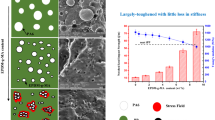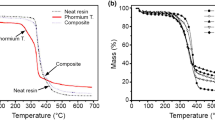The structure, the mechanical characteristics and the tribological properties of polyimide (PI)- and polyetherimide-(PEI) based composites, differing by the presence of ‘hinged’ oxygen atoms in the polymer molecular chain, are studied. The composites are reinforced with chopped carbon fibers and simultaneously loaded with organic (PTFE) and inorganic (MoS2) solid lubricant fillers. The tribological tests are carried out according to the ball-on-disk scheme under dry sliding friction on a ceramic counterface in the temperature range of T = 23−180°С. It is shown that only the PEI/10% CF/10% PTFE composite possesses the highest wear resistance in the entire experimental temperature range. At the same time, loading with PTFE particles ensures the formation of a stable layer (transfer film) of the secondary structures and its adherence to the sliding surface of the polymer composite, thus protecting it from wear. The changes in wear rate and friction coefficient are well correlated with each other. In the case where a MoS2 solid lubricant filler is loaded, the transfer film is fixed on the composite sliding surface only at the highest test temperature T = 180°С, which is due to the presence of oxygen atoms in the PEI molecules. This provides a low coefficient of friction and a relatively high wear resistance to the PEI/10 CF/10 MoS2 ternary composite. A comparative analysis of the tribological properties of the two types of polymer matrices have shown that the wear rate of the PEI-based composites loaded with PTFE is equally low at T = 23°C and 120°C, while at T = 180°C it is 300 times lower than that of the PI-based materials. This is thought to be due to the fact that a ‘more rigid’ PI matrix (without any hinged units in the macromolecule) is incapable of confining the solid PTFE lubricant in the transfer film layer under conditions of a high oscillating friction coefficient. The PEI-based composites are recommended for use in tribounits due to both high manufacturability governed by the polymer chain flexibility and high wear resistance due to the formation of stable secondary structures (transfer film) on the sliding surfaces in the temperature range of T = 23−180°С.
Similar content being viewed by others
References
H. R. Kricheldorf, Progress in Polyimide Chemistry. I, Springer Verlag, Berlin; Heidelberg (1999).
H. R. Kricheldorf, Progress in Polyimide Chemistry. II, Springer Verlag, Berlin; Heidelberg (1999).
C. P. Constantin, M. Aflori, R. F. Damian, and R. D. Rusu, Materials, 12, 3166 (2019).
R. Revathi, P. Prabunathan, and M. Alagar, Polymer Bull., 76 (1), 387 (2019).
Q. Fang, J. Wang, and S. Gu, J. Am. Chem. Soc., 137, 8352 (2015).
R. O. Jonson and H. S. Burlhis, J. Polymer Sci.: Polymer Symposia, 70, 129 (1983).
D. Parker, J. Vussinr, H. T. Grampel, et al., Ullmann's Encyclopedia of Industrial Chemistry, Wiley, Weinheim, Germany (2012).
M. H. Cho and S. Bahadur, Wear, 258, 835 (2005).
K. Friedrich, Adv. Industrial and Eng. Polymer Res., 1, No. 1, 3 (2018).
C. Cai, W. Wang, and J. Li, Appl. Mech. Mater., 66−68, 862 (2011).
G. J. Xian and Z. Zhang, Wear, 258, 776 (2005).
B. Li, W. Wood, L. Baker, et al., Polymer Eng. Sci., 50, 1914 (2010).
Z. Sun, Z-K. Zhao, and Y-Y. Zhang, Composit. Sci. Technol., 201, 108498 (2021).
J. Bijwe, J. John, and M. Fahim, Wear, 249(8), 715 (2000).
L. Mu, J. Zhu, J. Fan, et al., J. Nanomaterials, 2015, 1 (2015).
S. V. Panin, L. A. Kornienko, Le Thi My Hiep, et al., Russ. Phys. J., 63, No. 4, 554 (2020).
R. Gheisari and A. A. Polycarpou, Wear, 436−437, 203044 (2019).
S. V. Panin, S. A. Bochkareva, B. A. Lyukshin, et al., Phys. Mesomech., 24, 548 (2021).
B. Chen, X. Li, Y. Jia, et al., Composit. Part A: Appl. Sci. and Manufactur., 109, 232 (2018.
A. P. Krasnov, A. A. Askadskii, M. V. Gorshkov, et al., Doklady RAS, 479, No. 6, 639 (2018).
S. V. Panin, J. Luo, D. G. Buslovich, et al., Polymers, 13, 2837 (2021).
Author information
Authors and Affiliations
Corresponding author
Additional information
Translated from Izvestiya Vysshikh Uchebnykh Zavedenii, Fizika, No. 3, pp. 123–130, March, 2022.
Rights and permissions
Springer Nature or its licensor holds exclusive rights to this article under a publishing agreement with the author(s) or other rightsholder(s); author self-archiving of the accepted manuscript version of this article is solely governed by the terms of such publishing agreement and applicable law.
About this article
Cite this article
Panin, S.V., Luo, J., Buslovich, D.G. et al. Effect of the Matrix Structure on the Tribological Properties of Solid-Lubricant Composites Based on High-Temperature Polyimide Thermoplastics. Russ Phys J 65, 526–534 (2022). https://doi.org/10.1007/s11182-022-02664-8
Received:
Published:
Issue Date:
DOI: https://doi.org/10.1007/s11182-022-02664-8




